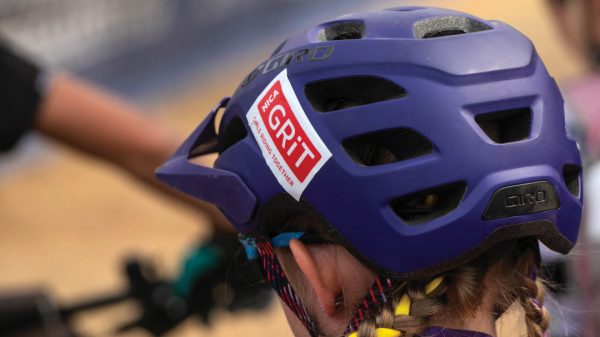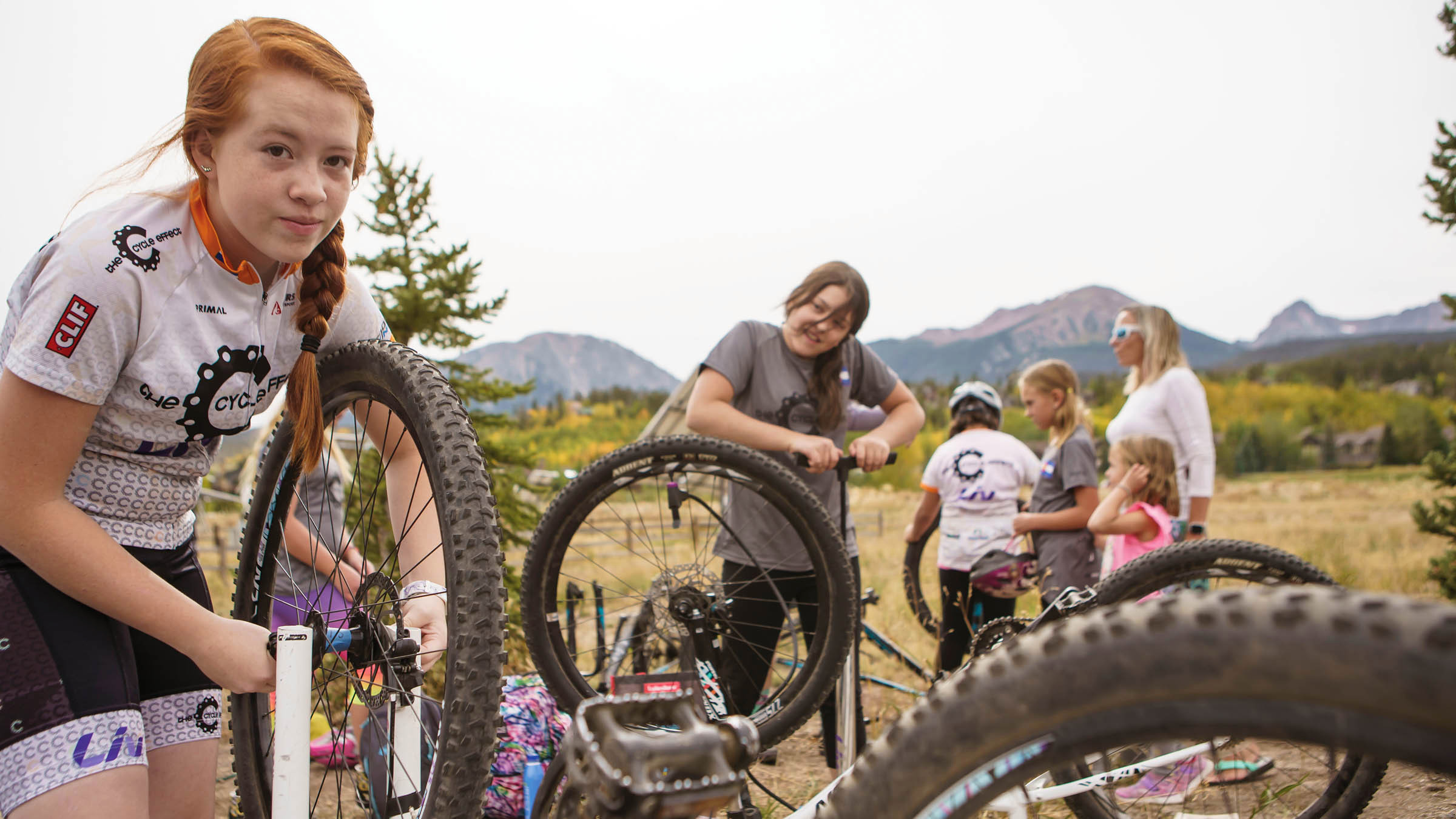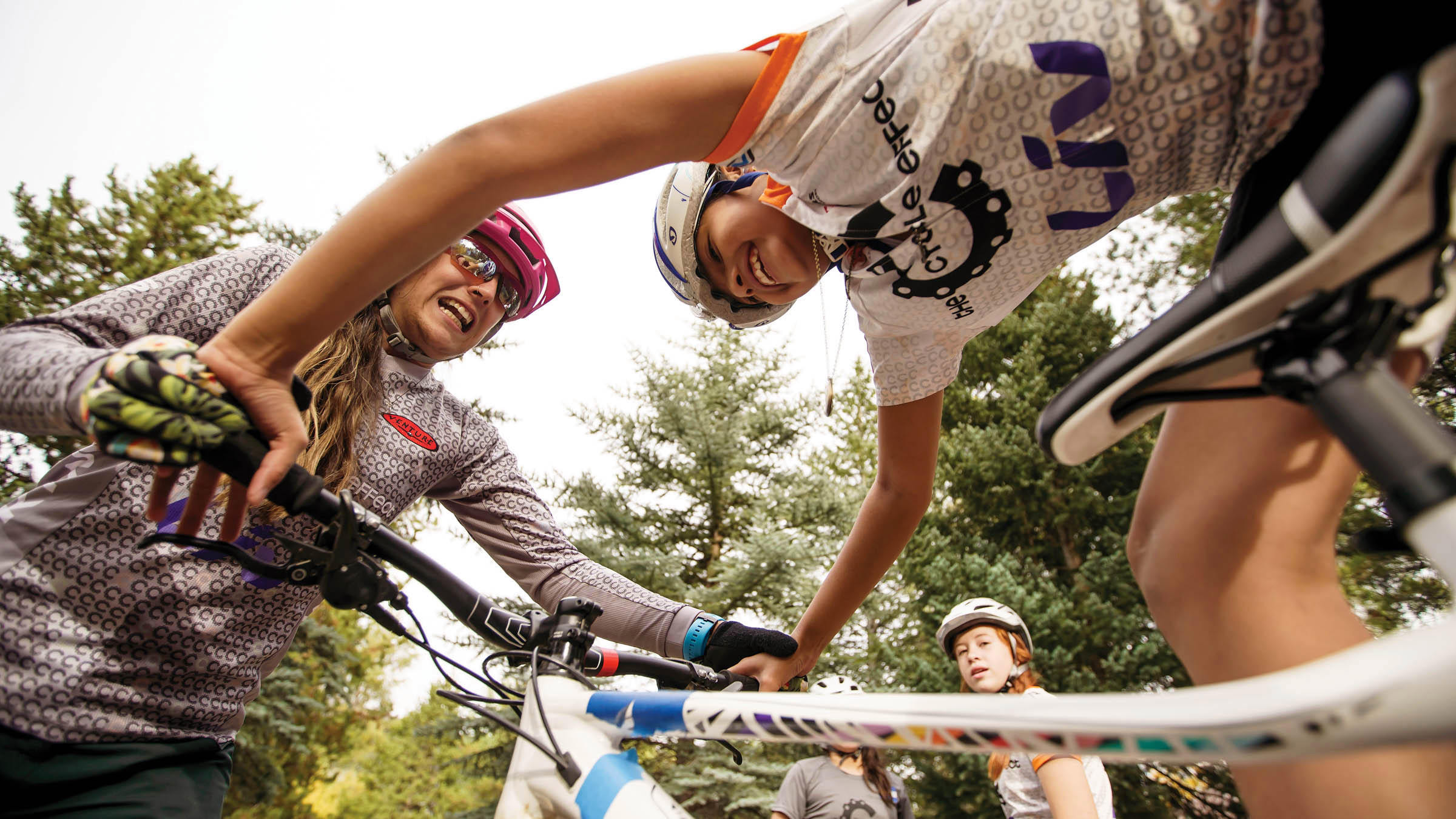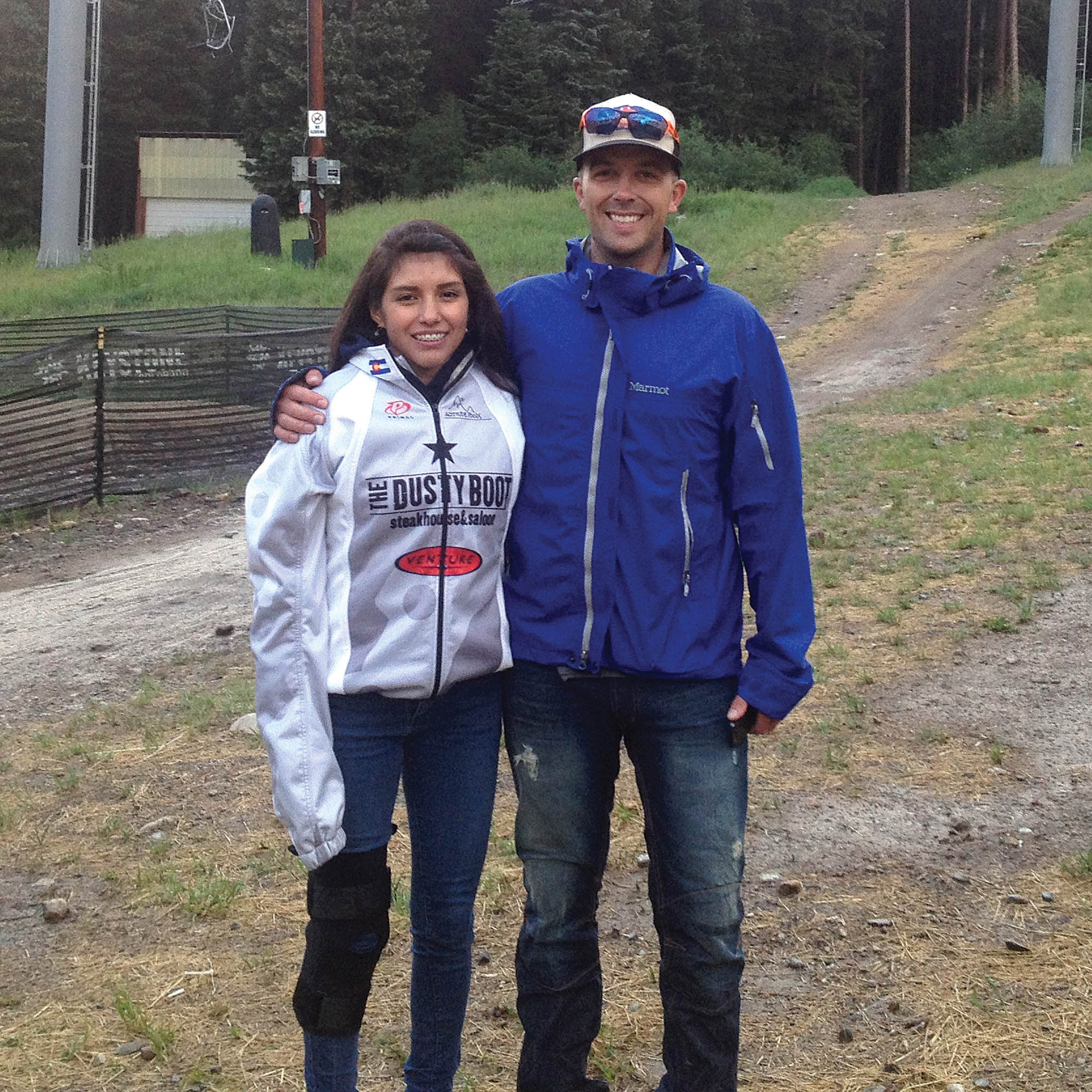Harley, 17, smiles as she recounts her favorite memory from her bike riding trip to Moab, Utah, last spring with The Cycle Effect, a Colorado-based mountain-bike group for girls. The group’s coaches stayed in one house while the girls stayed in another. Brett Donelson, the head coach, told the girls to go to sleep no later than 9:30 p.m., Harley says, replaying the scene.
“When he came over, we were all in the living room playing UNO until midnight,” Harley says. “But he was right, it’s super hard to mountain bike on very little sleep.”
Harley’s story is one of multiple anecdotes that these girls tell me throughout our video conferencing call. I had been slated to ride with Harley, and Ana Maria, Lilo, Karen, Levi, and Marin for The Cycle Effect’s 2020 trip to Moab, but due to the global coronavirus pandemic, we are connecting on a Google Hangouts video chat.
As the girls become accustomed to the awkwardness of the video call, more of their stories from Moab emerge. There was the time they all challenged Brett to an uphill climb in Arches National Park, and then raced him back down.
“He totally lost and made up an excuse that he was ‘talking’ to someone at the bottom,” says Lilo.
We pivot the conversation from the past to the future, and each of the girls tells me what she’s looking forward to for 2020. Tam Donelson, the program’s co-founder and wife to Brett, asks for a progress report on the week’s wheelie and trackstand challenge.
Ana Maria, who is recovering from hip surgery, hasn’t been able to participate in the wheelie challenge yet, but she’s been with the program for four years, so she’s not too worried.
“Mentally, I’m doing really good wheelies,” she says. “Plus, when Brett texts us and says, ‘OK who’s doing this challenge?’ It really motivates me and makes me realize what good friends I have that I can do these random competitions on the weirdest things.”
Youth cycling programs like The Cycle Effect are growing in popularity these days, as the National Interscholastic Cycling Associations’ (NICA) numbers soar, and kids outnumber adults at state and regional mountain bike competitions. Yet The Cycle Effect has made a bold decision: It’s only working with girls.
Why? Most youth cycling programs are composed almost entirely of boys. In 2019, only 20 percent of NICA’s 22,752 student-athletes were girls. This disparity has left coaches and directors asking themselves tough questions: Why is it harder to get girls engaged with bike programs? Once a girl starts riding, how do you convince her to stay with the sport? And how do you help young girls overcome the hurdles that are inherent to cycling?
All youth cycling groups are cognizant of the struggles around female participation.
“We’ve known that this issue exists,” says Amanda Carey, NICA’s VP of Programs. “But it’s not a problem until you’ve tried to solve it.”
Two years ago, Carey helped develop NICA’s GRiT (Girls Riding Together) program as an effort to establish a national initiative that state leagues could reference when trying to bring more girls into their programs. Other co-ed programs are similarly dedicated to making sure girls feel welcome, and some, like The Cycle Effect, have focused their attention wholly on girls. The popularity of these programs is leaving a mark; more girls are toeing the start line at races, and program waitlists are full. Yet the most important indicators of success are measured far beyond the singletrack.

Bringing bikes to girls
The Moab trip that we’ve all missed out on is an important milestone on The Cycle Effect’s yearly calendar. First, it represents the evolution from winter to spring, when strength conditioning workouts at the local recreation center give way to riding outside. Second, it’s a chance to give some of the older girls in the program, the high schoolers like Ana Maria and Marin and Karen, a chance to focus on something other than their singletrack skills. They are expected to take on leadership roles within the program, and it’s something they do willingly.
For seven years, The Cycle Effect has been giving 5th-12th grade girls in the Colorado mountain communities of Eagle, Summit, and Mesa counties the opportunity to ride and race mountain bikes. Yes, the program provides a bike and gear and coaching to girls who may not otherwise have the resources for such things. The program also places a huge emphasis on mentorship, leadership, nutrition, college readiness, and career exploration. Although the girls eventually fall in love with riding bikes, it’s those life-enhancing skills that make them stay with the program.
When Brett and Tam Donelson launched The Cycle Effect in 2013, the couple quickly realized that getting girls to love mountain biking was harder than they thought. The duo wanted to work with the Latina population in Colorado’s mountain towns, and attracting young Latina girls proved a bigger challenge than they expected.
“We assumed that our first girls would just want to ride bikes,” Brett Donelson says. “And nothing could have been further from the truth.”
Just three weeks after the Donelsons launched the program, they learned the hard way that the girls had already lost interest.
“They stopped showing up,” he says.
Youth cycling experts believe there are myriad reasons why girls and boys react differently to cycling programs. Steve Matous, the president of NICA, has spent much of his 18 months with the organization to try and understand these differences.
“What I hear mostly from 12- to 18-year-old [girls] is that they don’t want to be the only one,” he says.
Young girls are more likely to join activities if their friends or siblings are doing them too. In fact, the best recruitment tool for a program is the girls themselves, so getting them in the door is paramount. According to Carey, part of the impetus behind creating GRiT was improving the initial interaction between girls and NICA.
“Girls just needed something a little bit different to feel welcome, to feel like NICA was a place for them,” she says.
To help attract more girls, NICA made the GRiT ‘toolbox,’ a readily available resource for its state leagues. Inside the GRiT playbook is a wide breadth of resources, from coaching advice to bike maintenance tips to workshop frameworks, all of which are aimed at girls. NICA officials hope the GRiT initiative lays the groundwork for future female participants.
There are signs that GRiT is working. In Montana, which debuted as a NICA state league in 2019, female participation hit 35 percent — well above the 20 percent national average. Matous believes the GRiT playbook helped coaches attract more girls.
Sometimes, however, rolling out the welcome mat isn’t enough. If cycling isn’t already a part of a community’s culture, efforts to recruit girls will fall flat in front of those who ultimately have the final say: their parents. Despite the best intentions of those trying to get kids on bikes, a one-size-fits-all formula might exclude an otherwise captive audience.
“Girls are not girls are not girls,” Brett Donelson says. “The industry is used to working with resourced kids. Even if you’re running a demo day and getting kids who’ve never been on a bike before — they still have to get to the demo day somehow.”
In an effort to reach girls from low-income families, Donelson learned that he had to bring The Cycle Effect to them, and not wait for the girls to show up. Thus, he traveled to their schools, churches, clinics, and even their front yards. Donelson faced another hurdle with the parents of the girls he tried to invite. He struggled in his efforts, until a Latino member of the group’s board gave him some valuable advice.
“He’s like, ‘guys this is simple, run a potluck,’” Donelson says. “And now we run a monthly potluck and 60-80 people show up.”
Donelson’s success speaks to a larger point. Youth cycling programs succeed when they take the pulse of their community and adjust the formula accordingly. In Boulder, a city with a strong cycling culture, Boulder Junior Cycling’s director Pete Webber says that 40 percent of his high school-aged athletes are girls.
This is contrary to national statistics, which posit that by age 14, girls are 70 percent more likely to drop out of sports than boys. Since Webber doesn’t have to focus as much on inviting high school girls, he can focus on an equally important task: recruiting more women to coach them.

Winning over the locals
Isabel Rodriguez doesn’t ride a bike. And while Rodriguez has lived in Colorado’s skiing hotbed of Summit County for a decade, she’s only been on a snowboard twice.
Rodriguez, a former second grade teacher, was rightfully shocked when someone from The Cycle Effect’s board of directors approached her after a church service and asked her to run the program’s local chapter. Rodriguez had been asked to speak at the immigration-themed church service because of her firsthand experience working with immigrant children and their families as an elementary school teacher. She told the board member as much, and reminded him that she had started a dance program at her school, not a bike program.
“I told him that I didn’t think the two things were related at all,” Rodriguez says. “But he said that what I was doing was the same thing as the mission statement of The Cycle Effect, that I was empowering the population they were trying to serve.”
Despite Rodriguez’s lack of time on the bike, the Donelsons hired her as the program coordinator for Summit County.
“We bring in people who are there to connect with the girls,” Brett Donelson says. “Coaching someone to coach mountain biking is easy. That’s one of the biggest changes we’ve made, we’re not looking for ‘bike people’ but we’re finding teachers, youth development people, and paying them comparably.”
Although it was hard for her to give up her career as a teacher and especially the folkloric dance program she’d spent the last eight years pouring her heart into, Rodriguez says that ultimately, it was The Cycle Effect’s mission that helped her make the decision.
“If this organization empowers young women like myself, then it should start with me,” she says. “My whole story is that. I feel like I am ‘the girl.’”
Rodriguez emigrated to the United States from Mexico as a child and became a citizen at age 13. She earned a full scholarship to Kent Denver, a prestigious private high school in Denver. She learned French and traveled abroad. She lived experiences, she says, “that my parents never could have given me.”
Rodriguez sees The Cycle Effect as another one of those opportunities. It’s not that immigrant parents don’t want their kids to ski or snowboard or mountain bike, but the barriers are often too great. When Rodriguez speaks to immigrant parents about her program, she remembers the way her own parents felt toward outdoor activity.
“I tell them, ‘we live in a mountain community, this is the culture your children are growing up in,’” Rodriguez says. “I’m here to show you how we can make it possible.”

A need for mentors
If girls join cycling programs because of their friends, they stay because of the adults. While all kids who participate in sports want a coach that cares about them, this seems to be especially true for young girls.
Carey, who coaches Idaho’s Teton Valley NICA composite team, says that the athlete-coach relationship often has a bigger effect on girls than boys.
“For girls, especially at a younger age, it takes a little more time to show them that you care, that you’re interested in them as a person,” she says. “And it ultimately strengthens the relationship.”
NICA has decided that having more women in coaching and leadership roles is so crucial that they’ve woven it into the fibers of the GRiT program. Although GRiT stands for ‘girls riding together,’ the initiative is equally focused on bringing more women into the program. In 2019, only 25 percent of NICA’s coaches were women. Carey says that some of the same tactics that the league has identified as successful in recruiting girls also apply when it comes to encouraging women to get involved. A large portion of the GRiT toolbox is information on how to recruit more women into coaching roles.
“I say to coaches, ‘what do you want your team to look like?’” Carey says. “If you have one coach out of ten that’s a woman, that’s what your team looks like.”
In Boulder, Webber and his team have focused on understanding the barriers that prevent women from taking on coaching roles and have found that usually, it’s not a lack of desire but rather logistics that dictate women’s availability.
“Oftentimes they’re less flexible with their free time, less able to take on other things in life,” he says. “Or, they didn’t feel supported enough to do it. There’s a long list.”
Having compassionate, engaged, and motivated coaches and leaders is fundamental to the success of a girls cycling program. Donelson says that while The Cycle Effect tends to attract women to coaching and leadership roles, the organization considers any interested candidate. Even better are the ones who used to be participants themselves.

Building leadership
Isidra Luna remembers that one race at Keystone.
“There was this downhill part,” she says, “with big switchbacks, and I just remember my friend Ali who was ahead of me and she went straight through the switchback and hit a tree, and I was like, OMG, I need to stop!”
Luna and her friend Ali crossed the finish line together. That was in 2014, when Luna was a high school senior. After she graduated, Luna headed to college to begin her Associate of Science degree, but she’s not done with mountain bikes. Currently, Luna is working full-time at a community health center and also coaching girls with The Cycle Effect.
In my eyes, Luna is the ultimate success story.
Bret Donelson says he initially struggled to measure the program’s success, and how to steer the program’s graduates. The number of years each girl stayed with the program was one measure of success, but the metric wasn’t fair to those that moved away. Acceptance into college is another bright mark — 100 percent of girls who completed three years in the program and graduated high school in 2018 went on to college. Still, that number didn’t capture the program’s full scope.
“We knew we were building these girls to be tough,” Brett Donelson says. “We just didn’t know that it was called ‘grit.’”
The “grit” that Donelson is referring to is the concept that Dr. Angela Duckworth presented in her TED Talk and book by the same name, Grit: The Power of Passion and Perseverance. She developed the Grit scale, which measures the extent to which someone is able to maintain focus and interest and persevere in obtaining long-term goals. When The Cycle Effect began to use that scale, Donelson says, he found that the girls were scoring 10-25 percent higher than the average high school student in the grit indicators. NICA considers skills other than wheelies and track stands as indicators of success, as well.
“Even though mountain bike racing is what we do, we consider ourselves a youth development organization,” Matous says. “Tenacity, self-awareness, compassion, community — all of that is an important part of what we’re doing.”
One of the tenets of The Cycle Effect’s programming is that the girls participate in at least two races during the season. They can do more if they chose to, but they have to race at least twice. When I ask the high school girls what they think about racing, I expect to get a few ho-hum answers.
“At the beginning of the race, I’m super excited but then I get super nervous, and then I start racing, and I’m like ‘why did I do this?’” Harley says. “But then it’s so pretty, and I take a minute to appreciate what I’m doing and where I live and all the opportunities I’ve been given, and I just hammer.”
Brett Donelson says that he believes that the emotions that girls feel — both good and bad — at a start line parallel the feelings they might have later in life at a college or job interview; “important spaces in your life where they’re going to feel fear and not want to walk away from it.”
For Luna, coaching girls who are just a few years younger than her feels like one of those scary spaces. Can she be a role model? Does she have anything to offer them? Looking back on her own experience in the program, Luna believes her coaches helped her realize her own potential.
“Us Latinas, we kinda limit ourselves,” she says. “We don’t see our full potential in things. When you have someone there for you, like a coach, giving you a pat on the back, it’s empowering.”
The fundamental premise of any youth cycling program is to make kids feel empowered on a bicycle. With this goal in mind, it’s even more important to get more girls involved in these programs. That’s why Carey knows that NICA, even with its extraordinary growth, can’t back away from its efforts to bring in more girls.
“We don’t need to focus on that 20 percent,” she says. “Those girls are already getting to us somehow. We need to focus on the other 80.”
Kids are brutally honest. If the adults in charge continue the work of removing the barriers of getting girls on bikes, they only need to listen to the girls to guarantee continued success. This point is illustrated by Lilo, who tells me that she was attracted to The Cycle Effect by her older sister. She was in fifth grade and marveled at the way cycling impacted her sibling.
“I was always so inspired by her. I’d go to her bike races and see her crushing it and her coaches were so positive,” Lilo says. “I wanted to be in that position where I was strong and capable. It’s helped me in so many ways.”


